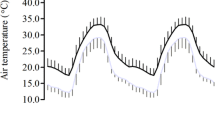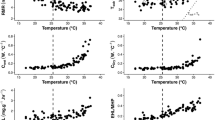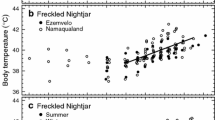Summary
The body temperature of free-ranging Andean toadsBufo spinulosus was measured either directly or radiotelemetrically during two 15-day periods at 3200 m elevation in the Mantaro Valley, Central Perú. All toads attempted to maintain their diurnal sum of body temperature within a narrow range. Consequently thermoregulatory behaviour differed according to cloud cover and precipitation. If the sky was clear, toads emerged from their hiding place and exposed themselves to solar radiation during 3–5 h in the morning. Core temperature increased up to 15° C above the air temperature in shade and reached maximum values of about 32° C. At air temperatures (in sun) exceeding 29° C, toads maintained body temperatures below 32° C by evaporative cooling. Following heliothermic heating during the moring toads retreated to the shade, thereby decreasing body temperature below air temperature. Under overcast sky toads remained exposed during the whole day displaying body temperatures at or slightly above ambient levels. Quantitative models to predict the core temperature of toads under the different weather conditions demonstrated that the substrate temperature was the main energy source accounting for 64.6–77.9% of total variance whereas air temperature was of minor importance (1.5–4.4%). The unexplained variance was probably due to evaporative cooling. The volume of urine stored into the urinary bladder of toads varied diurnally; during basking in the morning hours most bladders contained large volumes of urine, whereas during the afternoon the bladders were mostly empty. The bladder contents probably serve as water reserves during basking when evaporative water loss was high. Toads preferred sites that provided shady hiding places as well as sun-exposed bare soil within a radius of 5 m. However, they frequently changed their centers of activity and moved to other sites in 20–70 m distance after periods of 2–5 days. The helio-and thigmothermic behaviour of the Andean toad permits the maintenance of high core temperature during morning which probably increases the digestion rate and accelerate growth. Evaporative cooling and preference of shady sites were employed to regulate body temperature below the morning levels in response to the constraints of water balance. Periodic changes between thigmothermic behaviour and locomotory activity during the night maintains body temperature above air temperature and prolongs the period of food uptake.
Similar content being viewed by others
References
Alvarado RH (1979) Amphibians. In: Comparative physiology of osmoregulation in animals (ed. Maloiy GMO), Academic Press, Vol 1: 261–304
Brattstrom BH (1968) Thermal acclimation in anuran amphibians as a function of latitude and altitude. Comp Biochem Physiol 24:93–111
Brattstrom BH (1970) Amphibia. In: Comparative physiology of thermoregulation (ed. Whittow GC), Academic Press, Vol 1:135–166
Brattstrom BH (1979) Amphibian temperature regulation studies in the field and laboratory. Am Zool 19:345–356
Carey C (1978) Factors affecting body temperatures of toads. Oecologia 35:197–219
Cei JM (1972) Bufo of South America. In: Evolution in the genus Bufo (ed. Blair WF), Univ Texas Press: 80–92
Duellman WE (1979) The herpetofauna of the Andes: patterns of distribution, origin, differentiation and present communities. In: Duellman WE (ed) The South American herpetofauna: its origin, evolution, and dispersal. Monogr Mus Nat Hist Univ Kansas 7:371–460
Farrel MP (1971) Effect of temperature and photoperiod on the water economy of Hyla crucifer. Herpetologica 27:41–48
Freed AN (1980) An adaptive advantage of basking behaviour in an anuran amphibian. Physiol Zool 53:433–444
Geise W, Linsenmair KE (1986) Adaptations of the reed frog Hyperolius viridiflavus (Amphibia, Anura, Hyperoliidae) to its arid environment. II. Some aspects of the water economy of Hyperolius viridiflavus nitidulus under wet and dry season conditions. Oecologia 68:542–548
Lillywhite HB (1970) Behavioural temperature regulation in the bullfrog, Rana catesbeiana. Copeia 1970:158–168
Lillywhite HB (1971) Thermal modification of evaporative water loss in the frog, Rana catesbeiana. Z Vergl Physiol 73:84–104
Lillywhite HB, Licht P, Chelgren P (1973) The role of behavioural thermoregulation in the growth energetics of the toad, Bufo boreas. Ecology 54:375–383
Pearson OP, Bradford DF (1976) Thermoregulation of lizards and toads at high altitudes in Peru. Copeia 1976:155–170
Pough FH (1980) The advantages of ectothermy for tetrapods. Am Nat 115:92–112
Shoemaker VH, McClanahan LL, Withers PC, Hillman SS, Drewes RC (1987) Thermoregulatory response to heat in the waterproof frogs Phyllomedusa and Chiromantis. Physiol Zool 60:365–372
Sinsch U (1984) Thermal influences on the habitat preference and the diurnal activity in three European Rana species. Oecologia 64:125–131
Sinsch U (1986) Anfibios de la sierra central del Peru — Una clave de identificacion para adultos y larvas. Boletin de Lima 45:23–33
Sinsch U (1988) El sapo andino Bufo spinulosus: analisis preliminar de su orientacion hacia sus lugares de reproduccion. Boletin de Lima 57:83–91
Smits AW (1984) Activity patterns and thermal biology of the toad Bufo boreas halophilus. Copeia 1984:689–696
Tracy CR (1976) A model of the dynamic exchanges of water and energy between a terrestrial amphibian and its environment. Ecol Monogr 46:293–326
Vellard J (1959) Estudios sobre batracios andinos. V. El genero Bufo. Mem Mus Hist nat “Javier Prado” 8:1–48
Author information
Authors and Affiliations
Additional information
Dedicated to Prof. Dr. H. Schneider on the occasion of his sixtieth birthday
Rights and permissions
About this article
Cite this article
Sinsch, U. Behavioural thermoregulation of the Andean toad (Bufo spinulosus) at high altitudes. Oecologia 80, 32–38 (1989). https://doi.org/10.1007/BF00789928
Received:
Published:
Issue Date:
DOI: https://doi.org/10.1007/BF00789928




